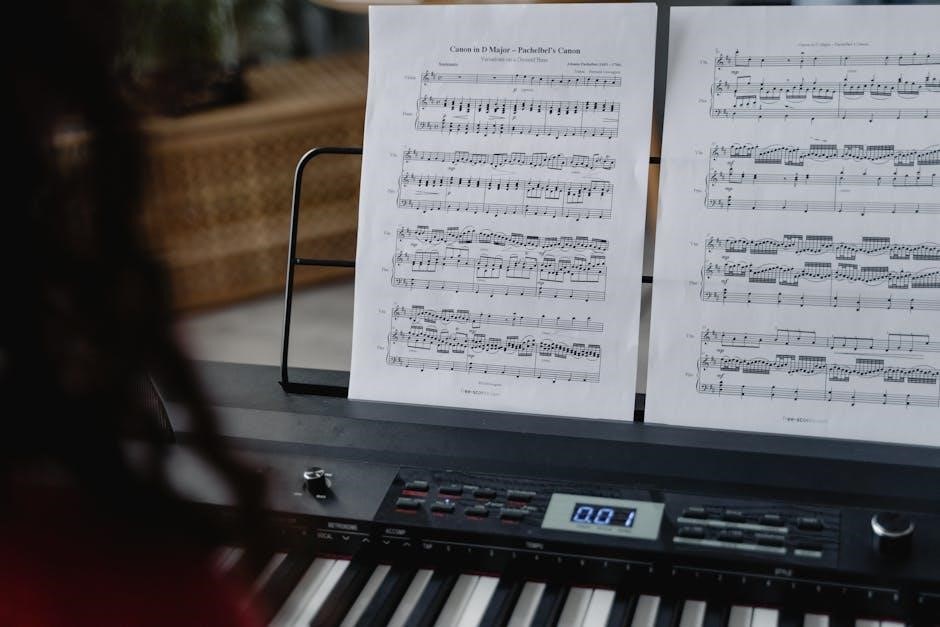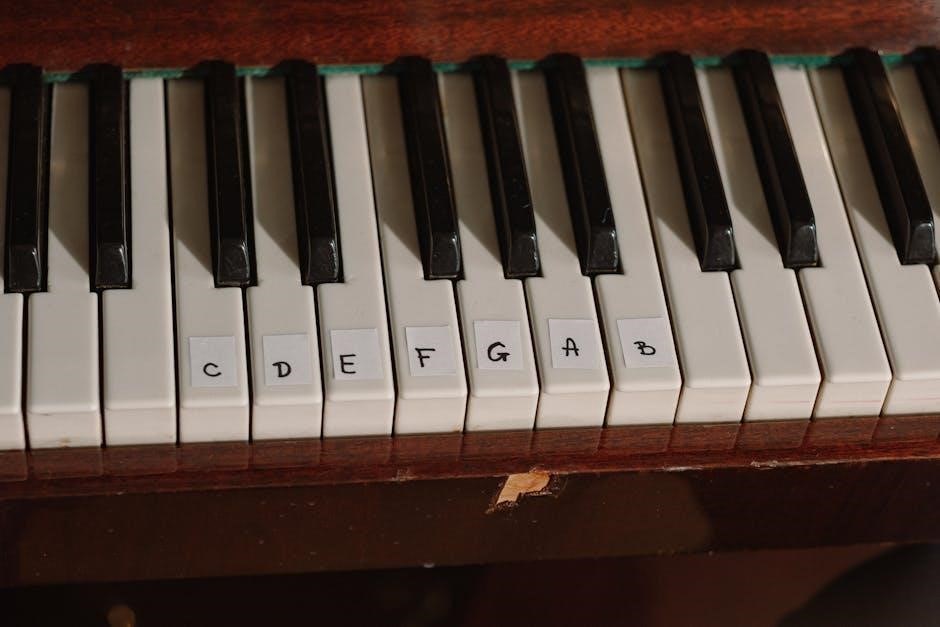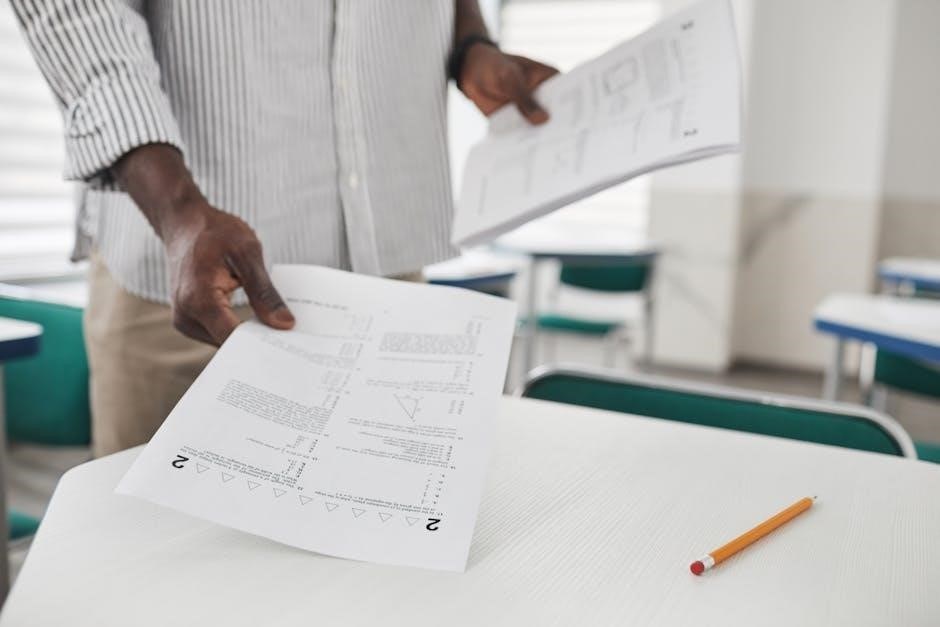Mastering piano chords is essential for beginners, as they form the foundation of music. With free PDF resources and chord charts, learning becomes straightforward and enjoyable.
What Are Piano Chords?
Piano chords are groups of musical notes played simultaneously, creating harmonic sounds. They are the building blocks of music, essential for composing and playing songs. Chords can be major, minor, seventh, or other variations, each with a unique sound and emotional impact. Understanding chords is crucial for beginners, as they form the foundation of most melodies and harmonies.

Chords are typically defined by their root note and the intervals between notes. For example, a C major chord consists of C, E, and G. These combinations can be found in free PDF resources and chord charts, making learning accessible. Chords are versatile and used across all music genres, from classical to pop, making them a fundamental skill for any aspiring pianist.
Why Learning Piano Chords is Essential for Beginners
Learning piano chords is vital for beginners as they provide the harmonic foundation of music. Chords enable players to accompany melodies, improvise, and understand song structures. By mastering chords, beginners can play popular songs more quickly, boosting confidence and motivation. Chords also enhance musical understanding, allowing for creativity and expression. Free PDF resources and chord charts simplify the learning process, making it accessible to practice and memorize essential chords. This foundational skill opens doors to various musical styles and genres, making chord learning an indispensable step in any pianist’s journey.

Understanding the Basics of Piano Chords
Mastering piano chords begins with understanding their structure and role in music. PDF guides offer clear diagrams and exercises to help beginners grasp chord fundamentals efficiently and effectively.
The Structure of a Chord
A piano chord is a group of three or more notes played together. The basic structure includes a root note, a third, and a fifth, forming a triad. For example, a C major chord consists of C, E, and G. These notes are played simultaneously to create harmony. Understanding this structure is crucial for beginners, as it forms the foundation for all chords. PDF guides often provide visual aids like diagrams and charts to help learners identify and play these notes correctly on the keyboard. This clear structure makes learning chords systematic and accessible, even for those new to piano music.
Major vs. Minor Chords: Key Differences
Major and minor chords are fundamental in music, differing in sound and emotional impact. A major chord, like C Major (C, E, G), has a bright, happy sound. A minor chord, such as A Minor (A, C, E), produces a sadder, more introspective tone. The difference lies in the third interval—the major third in major chords and the minor third in minor chords. For instance, the third note in a C Major chord is E, while in C Minor, it’s Eb. These distinctions are vital for beginners to understand, as they shape the mood of music. PDF guides often highlight these differences with clear examples and exercises, making it easier to identify and play each type effectively;
Understanding Chord Symbols and Notation
Chord symbols are shorthand representations of chords, guiding pianists on which notes to play. For example, “C” denotes a C Major chord (C, E, G), while “Cm” stands for C Minor (C, Eb, G). Seventh chords, like “C7” (C, E, G, Bb), add an extra note for depth. Symbols like “aug” (Caug) or “dim” (Cdim) indicate augmented or diminished chords. Notation may also include numbers (e.g., “Cmaj7”) for clarity. PDF guides often provide charts and formulas to decode these symbols, making it easier for beginners to translate them into actual keys on the piano. Mastery of these symbols is crucial for reading sheet music and playing chords accurately.

How to Read Piano Chord Charts and Sheets
Learning to read piano chord charts and sheets is a vital skill for beginners. PDF guides provide clear diagrams and symbols, making it easy to understand and play chords effectively.
A chord chart is a visual tool that displays piano keys and chord shapes. For beginners, it simplifies learning by showing which notes to play. PDF downloads offer clear layouts, making it easy to identify major, minor, and seventh chords. These charts often color-code keys or use symbols to represent fingers, guiding hand placement. They also provide staff notations, helping to connect chords with sheet music. With a chord chart, newcomers can quickly grasp chord structures, practice transitions, and build confidence. Regular use of these resources accelerates mastery, making them indispensable for effective learning;
How to Read Sheet Music for Chords
Reading sheet music for chords involves understanding notation and symbols. Start by identifying the staff, where notes are placed. The treble clef (right hand) and bass clef (left hand) indicate pitch. Locate middle C, the central note, and recognize note values (whole, half, quarter) to determine rhythm. Chords are represented by stacked notes or symbols like C, Cm, or C7. Match these to keyboard keys using finger numbers (1-5 for right hand, 1-5 for left). Practice deciphering chord progressions by arpeggiating or playing all notes simultaneously. With practice, you’ll master interpreting sheet music, enabling smooth chord transitions and harmonic playing.
Most Common Piano Chords for Beginners
Learn the most common piano chords for beginners, including major chords like C and G, minor chords like A minor and E minor, and seventh chords like C7 and G7.
Major Chords: C, G, Am, and More
Major chords are the building blocks of music, offering a bright and uplifting sound. For beginners, the C major chord is a great starting point, consisting of the notes C, E, and G. Similarly, the G major chord, made up of G, B, and D, is another essential chord. These chords are fundamental because they are simple to play and are used in countless songs. By mastering these, you can quickly begin playing popular tunes. Additionally, the Am (A minor) chord, while technically minor, is often included in this category for its common use. Download a free PDF chord chart to practice these chords effectively and improve your skills.
Minor Chords: A Minor, E Minor, and Others
Minor chords add depth and emotion to music, making them a crucial part of a beginner’s toolkit. The A minor chord, for instance, consists of the notes A, C, and E, creating a melancholic yet beautiful sound. Similarly, the E minor chord, comprising E, G, and B, is another essential minor chord frequently used in songs. These chords are relatively simple to learn and are foundational for playing various genres of music. By practicing minor chords like A minor and E minor, beginners can expand their musical range and enhance their ability to express emotion through playing. Downloading a piano chords PDF can provide clear visuals and step-by-step guides to master these chords efficiently.

Seventh Chords: C7, G7, and Their Variations
Seventh chords, such as C7 and G7, add a rich, complex sound to music. They are formed by adding a seventh note to a major triad, creating a deeper harmonic texture. For example, a C7 chord consists of C, E, G, and Bb, while a G7 chord includes G, B, D, and F. These chords are versatile and commonly used in jazz, blues, and pop music. Variations like minor seventh chords (e.g., Am7) or dominant seventh chords (e.g., E7) further expand musical possibilities. Beginners can start with C7 and G7, as they are foundational and frequently used. Practicing these chords will enhance your ability to play emotionally expressive and nuanced music. A piano chords PDF can provide clear diagrams for mastering these chords effectively.

Practical Tips for Mastering Piano Chords
Start with major chords, use a chord chart, and practice step-by-step. Focus on hand positioning, finger placement, and smooth transitions. Regular practice and patience are key to progress.
Step-by-Step Practice Routine for Beginners
A effective practice routine involves starting with major chords like C, G, and Am. Begin by identifying notes on the keyboard using a chord chart. Play each note in the chord simultaneously to ensure clarity. Gradually incorporate minor chords, such as A minor and E minor, focusing on smooth transitions. Dedicate time to practicing seventh chords like C7 and G7, which add depth to your playing. Use a metronome to improve timing and rhythm. Practice scales alongside chords to enhance finger dexterity and understanding of harmony. Regular, consistent practice, even for short durations, will lead to steady progress and mastery of piano chords.
Using a Piano Chords PDF for Effective Learning
A piano chords PDF is a valuable resource for beginners, offering a structured approach to learning. These files typically include chord charts, formulas, and exercises, making it easy to visualize and practice chords. Printable PDFs allow you to focus on finger placement and note combinations without distractions. Many PDFs are designed for all skill levels, covering major, minor, and seventh chords. They often include interactive elements or backing tracks to enhance practice sessions. By using a piano chords PDF, you can access lessons anytime, even without internet, and track your progress effectively. This tool simplifies learning and helps build a strong foundation in piano chords.
Mastery of piano chords opens endless musical possibilities. With consistent practice and resources like chord PDFs, beginners can confidently progress. Keep exploring and enjoying the journey of learning!
Summarizing Key Takeaways
Understanding piano chords is foundational for beginners, as they form the basis of most songs. Major, minor, and seventh chords are essential to learn. Using resources like free piano chords PDFs and chord charts can simplify the learning process. Start with major chords such as C, G, and Am, then progress to minor chords like A minor and E minor. Seventh chords, such as C7 and G7, add depth to your music. Consistent practice and familiarizing yourself with chord symbols are crucial. Utilize step-by-step practice routines and downloadable piano chord charts to build a strong harmonic vocabulary. These tools will help you master the basics and unlock further musical growth.
Encouragement to Continue Practicing
Consistent practice is key to mastering piano chords. Celebrate small victories, like learning a new chord or playing a song smoothly. Use free piano chords PDFs and online resources to stay motivated. Break practice into manageable sessions to avoid overwhelm. Experiment with different chord progressions to apply your knowledge creatively. Joining a music community or finding a practice buddy can also keep you inspired. Remember, progress takes time, and every effort strengthens your skills. Keep exploring, and soon you’ll be playing your favorite songs with confidence. Enjoy the journey of learning and the joy it brings to create music.



